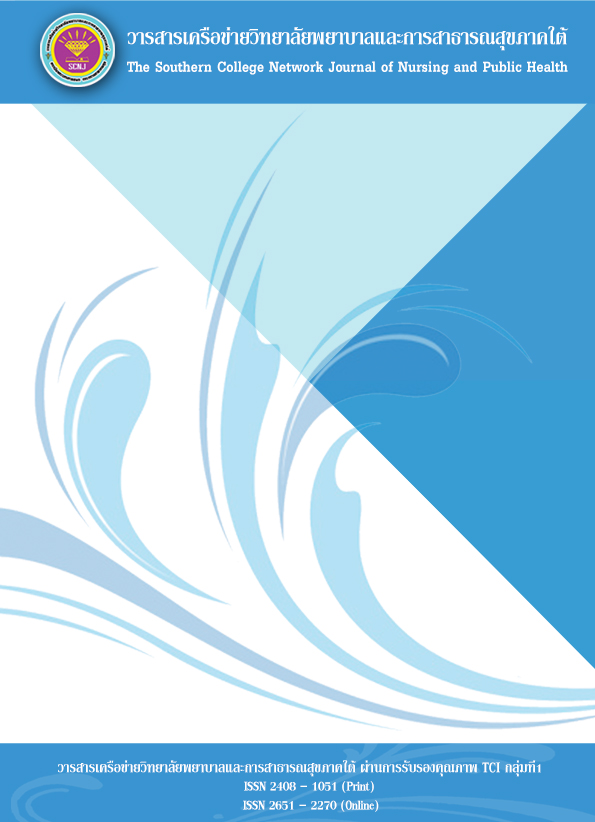การพัฒนารูปแบบการดูแลผู้ป่วยเบาหวาน จังหวัดลำปาง ปี 2561
คำสำคัญ:
การพัฒนา, รูปแบบการดูแล, ผู้ป่วยเบาหวานบทคัดย่อ
การวิจัยและพัฒนานี้ มีวัตถุประสงค์เพื่อพัฒนารูปแบบการดูแลผู้ป่วยเบาหวาน และประเมินผลลัพธ์ของรูปแบบการดูแลผู้ป่วยเบาหวาน จังหวัดลำปาง ปี 2561 ดำเนินการ 3 ระยะ ได้แก่ ระยะที่ 1 วิเคราะห์สถานการณ์การดูแลผู้ป่วยเบาหวาน ในบุคลากรสุขภาพ จำนวน 57 คน ด้วยการสนทนากลุ่ม วิเคราะห์ข้อมูลเชิงเนื้อหา ระยะที่ 2 การพัฒนารูปแบบฯ โดยบุคลากรสุขภาพ จำนวน 57 คน โดยจัดทำคู่มือการจัดการตนเองของผู้ป่วยเบาหวาน และการนำรูปแบบที่พัฒนาขึ้นไปใช้กับผู้ป่วยเบาหวาน ระยะที่ 3 การประเมินผลจากการใช้รูปแบบที่พัฒนาขึ้น (3 Change Model) ถอดบทเรียนการให้บริการ และประเมินความเป็นไปได้ ในบุคลากรสุขภาพ จำนวน 57 คน และผู้ป่วยเบาหวาน 548 คน เก็บข้อมูลโดยใช้แบบสอบถามและการสนทนากลุ่ม วิเคราะห์ข้อมูลโดยใช้ ร้อยละ ค่าเฉลี่ย ส่วนเบี่ยงเบนมาตรฐาน สถิติ Paired t-test และวิเคราะห์ข้อมูลเชิงเนื้อหา ผลการวิจัยพบว่า
1. รูปแบบการดูแลผู้ป่วยเบาหวาน จังหวัดลำปาง คือ 3 Change Model ได้แก่ 1) Change Mindset 2) Change Health Service 3) Change Patient’s Behavior
2. หลังการใช้รูปแบบการดูแลผู้ป่วยเบาหวาน 3 Change Model พบว่า บุคลากรสุขภาพปรับเปลี่ยนวิธีคิดอยู่ในระดับมาก (µ=4.09, σ=.23) และปรับเปลี่ยนบริการสุขภาพ อยู่ในระดับปานกลาง (µ=2.74, σ=.61) การปรับเปลี่ยนพฤติกรรมของผู้ป่วยเบาหวาน ด้านอาหาร ออกกำลังกาย อารมณ์และยา สูงกว่าก่อนใช้รูปแบบ อย่างมีนัยสำคัญทางสถิติที่ระดับ .001 (p<.001) ค่าเฉลี่ยระดับน้ำตาลในเลือดหลังใช้รูปแบบ (µ =8.74, σ =1.63) ลดลงกว่าก่อนใช้รูปแบบ (µ =9.21, σ =1.63) อย่างมีนัยสำคัญทางสถิติที่ระดับ .001 (t=7.880)
ดังนั้น มีการพัฒนาทักษะจำเป็นของบุคลากรสุขภาพสำหรับการสนับสนุนการจัดการตนเอง สนับสนุนให้ใช้คู่มือการจัดการตนเองและสนับสนุนเครื่องตรวจระดับน้ำตาลในเลือดรายบุคคล จัดบริการและดูแลโดยแพทย์เวชศาสตร์ครอบครัวในชุมชน
เอกสารอ้างอิง
Best, J. W. (1970). Research in Education. Englewood Cliffs, New Jersey: Prentice-Hall Inc.
Bureau of Non Communicable Diseases. (2017). World Diabetes Day. Retrieved January 2, 2017 from https://www.thaincd.com
Cronbach, L. J. (1951). Coefficient Alpha and the Internal Structure of Tests. Psychometrika, 16(3), 297-334.
Crabtree, B. F., & Miller, W. L. (1992). Doing Qualitative Research. London: SAGE Publications.
Cronbach, L. J. (1951). Coefficient Alpha and the Internal Structure of Tests. Psychometrika, 16(3), 297-334.
Diabetes Association of Thailand under the Patronage of Her Royal Highness Princess Maha Chakut Sirindhorn. (2017). Clinical Practice Guideline for Diabetes 2017. Romyen Media Company Limited. (in Thai)
Hair, F. J., Black, C. W., Babin, J. B., & Anderson, E. R. (2010). Multivariate Data Analysis. (7th ed). New Jersey: Pearson Education.
Lampang Provincial Health Office. (2017). Inspection and Supervision of the Ministry of Public Health. Health Region 1. Copied Document. (in Thai)
Likert ̉s Rating Scale. (1967). The Method of Constructing and Attitude Scale. Reading in Fishbeic, Matin (Ed.). Attitude Theory and Measurement. New York: Wiley & Son.
McNamara, J. P., Reid, A. M., Freedland, A. R., Righi, S. E., & Geffken, G. R. (2011). Contributing Factors to Poor Adherence and Glycemic Control in Pediatric Type 1 Diabetes: Facilitating a Move to Ward Tele Health. Type1 Diabetes-Complications, Pathogenesis, and Alternative Treatments: In Tech.
Pracha, C. (2013). Concepts, Theories on Health Promotion and Their Application. Nonthaburi: Academic Welfare Program Praboromarajchanok Institute Office of the Permanent Secretary for Public Health. (in Thai)
Prang, B., Duangkamol, P., & Sutteeporn, M. (2016). The Effectivenessof Self-management Program on Type 2 Diabetic Patients in Thakor, Maesuai District, Chiangral Province. Journal of The Police Nurses, 9(1), 105-116. (in Thai)
Rangseesakhon, O., Chanchay, S., Saowakontha, S., & Thiramanus, T. (2011). Factor Associated with Blood Sugar Controlling of Type 2 Diabetic Patients at Health Science Center Burapha University, Muang District, Chonburi Province [Dissertation]. Chon Buri: Faculty of Medicine, Burapha University.
Supaporn, P., Nantiya, W., & Nantawon, S. (2011). Factors Predicting Diabetes Self-Management Behavior among Patients with Diabetes Mellitus Type 2. Journal of Nursing Science, 29(4), 18-26. (in Thai)
Surattana, T., & Benjamas, S. (2016). A Situation Study of Using Chronic Care Model in Caring for Diabetes Type 2 Patients. Journal of Health Science Research, 10(2), 29-40. (in Thai)
Umaporn, K., Pavana, B., & Atchariya, W. (2016). The Development of Home Visit Guidelines for Patients with Type 2 Diabetes Mellitus or Hypertension Run by Family Care Team. The Southern College Network Journal of Nursing and Public Health, 4(Special Issue), 34-45. (in Thai)
Ungkannaporn, P., & Wiporn, S. (2017). Self-Management in Poor Clycemic Contral Type 2 Diabete Patients at Diabetes Clinic in Noungrua Hospital Khon Kaen Province. Research and Development Health System Journal, 11(1), 39-47. (in Thai)
ดาวน์โหลด
เผยแพร่แล้ว
ฉบับ
ประเภทบทความ
สัญญาอนุญาต
1. บทความหรือข้อคิดเห็นใด ๆ ที่ปรากฏในวารสารเครือข่าย วิทยาลัยพยาบาลและการสาธารณสุขภาคใต้ ที่เป็นวรรณกรรมของผู้เขียน บรรณาธิการหรือเครือข่ายวิทยาลัยพยาบาลและวิทยาลัยการสาธารณสุขภาคใต้ ไม่จำเป็นต้องเห็นด้วย
2. บทความที่ได้รับการตีพิมพ์ถือเป็นลิขสิทธิ์ของ วารสารเครือข่ายวิทยาลัยพยาบาลและการสาธารณสุขภาคใต้








